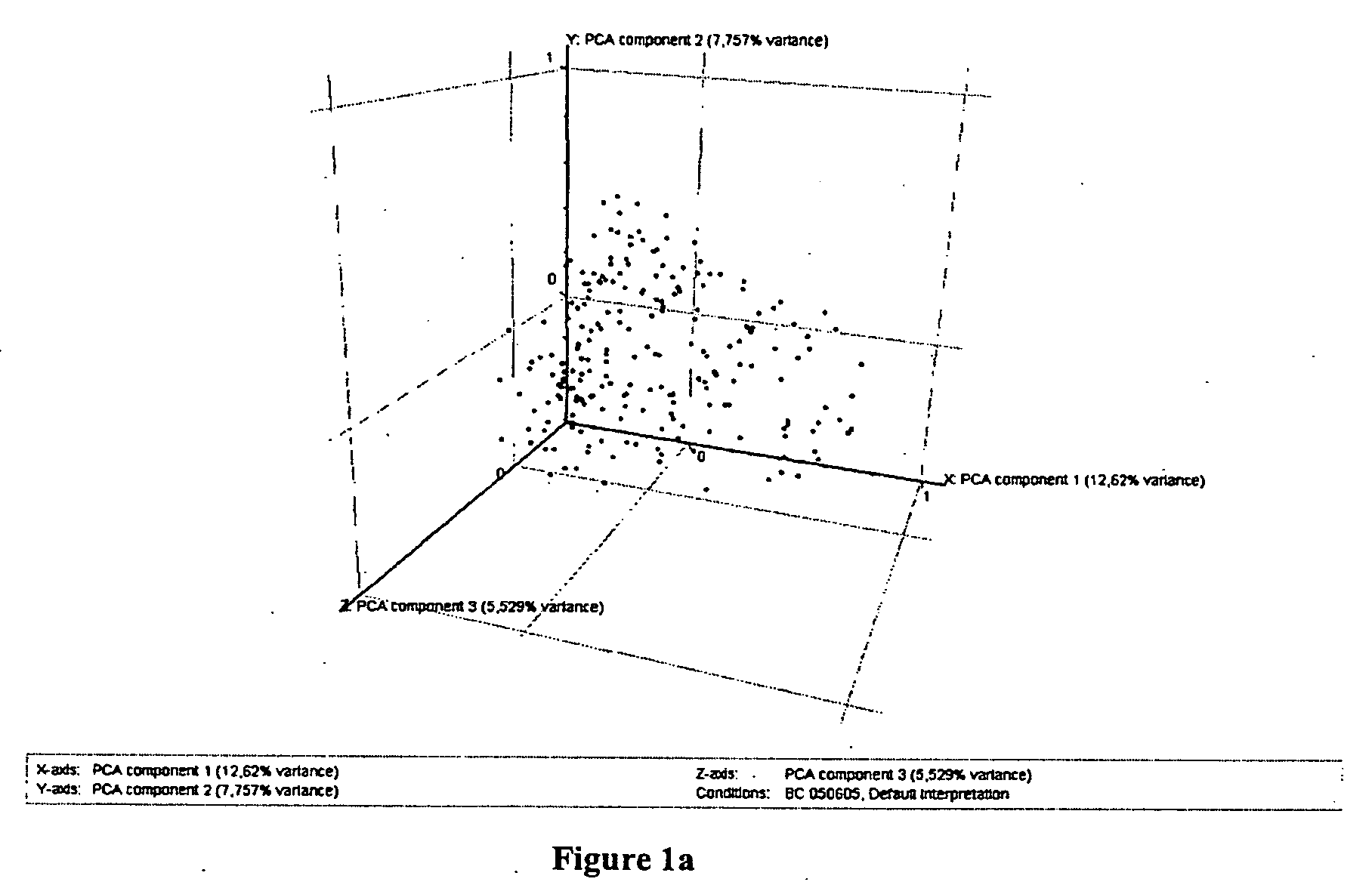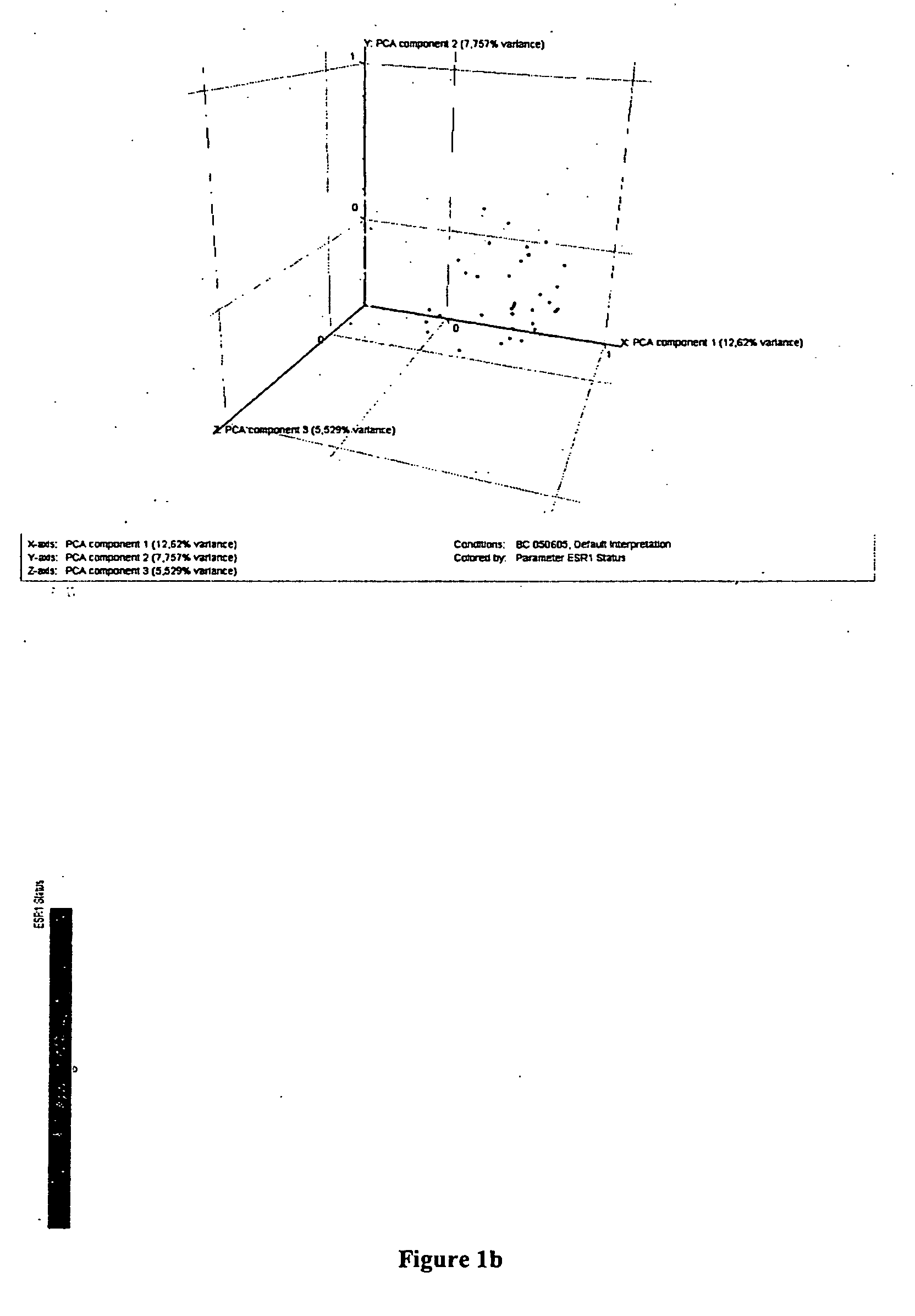Diagnosis, Prognosis and Prediction of Recurrence of Breat Cancer
a breast cancer and prognosis technology, applied in the direction of instruments, material analysis, measurement devices, etc., can solve the problems of severe impairment of patients' quality of life, low class prediction accuracy, so as to achieve the effect of a general predictor and a higher accuracy of test data
- Summary
- Abstract
- Description
- Claims
- Application Information
AI Technical Summary
Benefits of technology
Problems solved by technology
Method used
Image
Examples
example 1
Isolation of RNA From Tumor Tissue
[0093]RNA Isolation From Frozen Tumour Tissue Sections
[0094]Frozen sections were taken for histology and the presence of breast cancer was confirmed in samples from 212 patients. Tumor cell content exceeded 30% in all cases and was above 50% in most cases. Approximately 50 mg of snap frozen breast tumour tissue was crushed in liquid nitrogen. RLT-Buffer (QIAGEN, Hilden, Germany) was added and the homogenate spun through a QIAshredder column (QIAGEN, Hilden, Germany). From the eluate total RNA was isolated by the RNeasy Kit (QIAGEN, Hilden, Germany) according to the manufacturers instruction. RNA yield was determined by UV absorbance and RNA quality was assessed by analysis of ribosomal RNA band integrity on the Agilent Bioanalyzer (Palo Alto, Calif., USA).
example 2
Determination of Expression Levels
[0095]Gene Expression Measurement Utilizing HG-U133A Microarrays of Affymetrix
[0096]Starting from 5 μg total RNA labelled cRNA was prepared for all 212 tumour samples using the Roche Microarray cDNA Synthesis, Microarray RNA Target Synthesis (T7) and Microarray Target Purification Kit according to the manufacturer's instruction. In brief, synthesis of first strand cDNA was done by a T7-linked oligo-dT primer, followed by second strand synthesis. Double-stranded cDNA product was purified and then used as template for an in vitro transcription reaction (IVT) in the presence of biotinylated UTP. Labelled cRNA was hybridized to HG-U133A arrays (Santa Clara, Calif., USA) at 45° C. for 16 h in a hybridization oven at a constant rotation (60 r.p.m.) and then washed and stained with a streptavidin-phycoerythrin conjugate using the GeneChip fluidic station. We scanned the arrays at 560 nm using the GeneArray Scanner G2500A from Hewlett Packard. The readings ...
example 3
Labelling of Breast Cancer Samples into Subclasses After Principle Component Analysis
[0097]All 212*.chp files generated by MAS 5.0 were converted to *.txt Files and loaded into GeneSpring® software (Silicon Genetics, Redwood City, Calif., USA). An experiment group was created using the following normalisation settings. Values below 0.01 were set to 0.01. Each measurement was divided by the 50th percentile of all measurements in that sample. Each gene was divided by the median of its measurements in all samples. If the median of the raw values was below 10 then each measurement for that gene was divided by 10 if the numerator was above 10, otherwise the measurement was thrown out. Next, genes were filtered for quality with regard to the technical measurement. In a first step genes from the default list “all genes”. whose flags in the experiment group were “Present” in at least 10 of the 212 samples were selected for further analysis. Secondly, remaining genes were filtered for variab...
PUM
 Login to View More
Login to View More Abstract
Description
Claims
Application Information
 Login to View More
Login to View More - R&D
- Intellectual Property
- Life Sciences
- Materials
- Tech Scout
- Unparalleled Data Quality
- Higher Quality Content
- 60% Fewer Hallucinations
Browse by: Latest US Patents, China's latest patents, Technical Efficacy Thesaurus, Application Domain, Technology Topic, Popular Technical Reports.
© 2025 PatSnap. All rights reserved.Legal|Privacy policy|Modern Slavery Act Transparency Statement|Sitemap|About US| Contact US: help@patsnap.com



